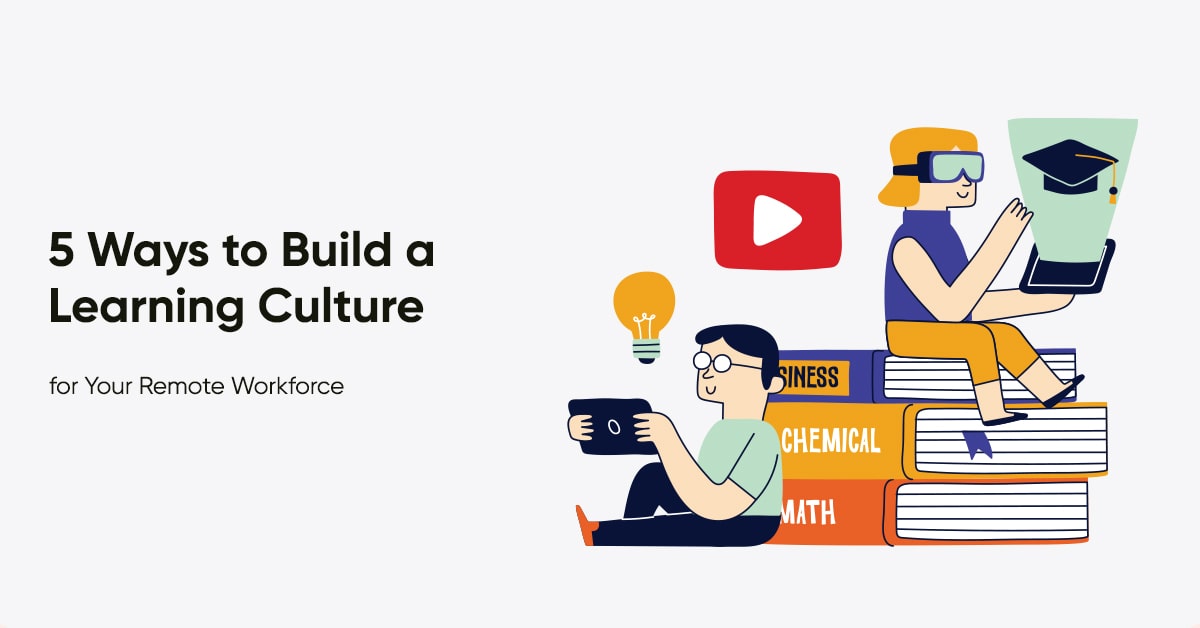5 Ways to Build a Learning Culture for Your Remote Workforce

Learning is an important part of any organization to grow. Building a culture that fosters and facilitates one allows it to adapt to a fast-changing business environment.
A learning culture is a social behavior is fostered by an organization that supports open-mindedness, facilitates activities that enhance knowledge, and encourages learning that allows organizations to achieve their mission and goals.
During the COVID-19 pandemic, learning has undergone a transformation in the workforce and business environment. Employees are mostly working remotely and in-person learning sessions have become limited for employee safety. Organizations face a challenge in providing and sustaining learning opportunities to their employees.
Creating a system that allows remote employees to continue training online is a solution. It allows building skills and capabilities of employees that are required for the organization to adapt to the disruptions to the business environment created by the pandemic.
Engaging and relevant courses and content in digital learning format are in demand. The challenge for organizations now is to instill a learning culture even when employees are working remotely.
What you should know:
A learning culture is important for organizations to thrive during a crisis. It helps them prepare for the changes that will come, especially after the pandemic.
Training online is massively different than hosting face-to-face learning. Organizations must take into account employees’ working schedules, internet connection speeds, or even personal interests and preferences.
Providing blended learning— synchronous and asynchronous— is one of the best ways for employees to learn. Using Learning Management Systems or other software that provides tools ensures that the learning process is smooth and easy.
It’s also equally important to build communities that are centered around specific interests or topics. Actively campaigning for learning as well as management support can give an extra push to employees to motivate them to attend training and sessions.
Five Ways to Build a Learning Culture for Remote Workforces
These are the ways organizations can foster a culture of learning to workers around the world stuck in their home offices:
1. Blended Learning
Blended learning means the type of learning organizations provide is a mix of synchronous and asynchronous learning.
Synchronous learning is training multiple learners at the same time on a given schedule. This means that employees have to attend a scheduled training session. Asynchronous learning is “self-paced,” where employees can choose when to access the provided content, when to make an assessment, and when to complete courses within given timelines.
Blended learning is one of the best ways to facilitate a good learning experience to employees.
2. Using Learning Management System and other tools
Technology is a game-changer in remote learning. Using a Learning Management System, a type of software that provides a centralized content library to employees, with a user-friendly interface, remote workers can learn systematically. It also makes it easier for organizations to smoothly facilitate training and assessments.
LMSs also provide accessibility from any device at any time. They can automate processes like inviting attendees, sending links to webinars or podcasts, providing specific courses, and assessing outcomes.
3. Building communities
Shared learning is an important aspect of the learning culture. Groups, teams, or communities built online can foster collaboration among employees that have the same interests or hobbies and improve their pace of learning.
Subject matter experts can break down complex concepts, simplify the learning process, and make subjects more engaging through videos, posts, tips, or even counseling sessions. They can also motivate employees to invest more of their time and energy into the endeavor.
4. Learning campaigns
Organizations can actively campaign for employee learning and discussing the importance of learning even when working remotely. They can market why it’s important to fill the skills gaps so they won’t have to prioritize work over learning during the crisis.
Explaining the rationale behind learning for career advancement can also help, especially when the lessons are connected to the business environment post-pandemic. Videos, teasers, or email alerts can create hypes that would encourage employees to participate in the activities.
5. Management support
Learning is not just the responsibility of the employee, it’s also the management’s. Building a learning culture requires empathy on the part of the management, taking into account the current situation of employees.
The management must be open to new ideas, must allow room for experimentation, must encourage employees to ask questions, take risks, and spark moments of success or even failure so employees continue to value learning.
Upgrade your organization now
Automate your work processes now. Get started here.
Curious how digital ecosystems can help improve your business?
Check out how digital ecosystems can boost your company performance by getting started here.
Book a Demo